
White markings or White spotting
Different genes affect the colours. One of these is the "Spotting" gene which causes a broken appearance to the coat with areas of colour as well as areas of white. Think of white as a mask hiding the colour beneath. Wherever there is a "hole" in the mask, the colour will show through. The official term for this is Particolour, although many other designations are used to identify the extent of white in the coat.
White spotting
There is an enormous variety of white markings but they are not nearly as random as imagined. White follows a very definite, ordered progression from a little to a lot.
Understanding the progression of white spotting brings one of those "AH HA!" moments. It clears up a lot of mysteries about the dizzying variation in the extent of white seen in Havanese.
Want to know more about it? Learn more and see photo examples on the spotting page.
Photos:
Photo examples of white spotting can be found in Gallery 5 and on the spotting page.
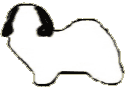 EXTREME PIEBALD: Two colour coat, white plus any other colour. Extreme white spotting, these very lightly marked dogs with less than 10% colour are sometimes called extreme Particolour or extreme Piebald. The dog is mostly white. An example might be a white dog with one or both ears partly coloured and no coloured patches on the body. See photos in Gallery 5.
EXTREME PIEBALD: Two colour coat, white plus any other colour. Extreme white spotting, these very lightly marked dogs with less than 10% colour are sometimes called extreme Particolour or extreme Piebald. The dog is mostly white. An example might be a white dog with one or both ears partly coloured and no coloured patches on the body. See photos in Gallery 5.
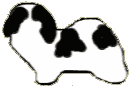 PARTI-COLOUR or PIEBALD: Two colour coat; white plus any other colour. Moderately colour marked. Coat is predominantly white, broken with irregular patches or spots of a second colour (less than 50% colour). Particolour is also used as a general term to indicate any dog with any extent of white markings.
PARTI-COLOUR or PIEBALD: Two colour coat; white plus any other colour. Moderately colour marked. Coat is predominantly white, broken with irregular patches or spots of a second colour (less than 50% colour). Particolour is also used as a general term to indicate any dog with any extent of white markings.
See photos in Gallery 5.
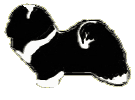 IRISH PIED: Two colour coat; white plus any other colour. Coat is predominantly coloured (more than 50% colour). Irish Pied markings are very specific. The underbelly, lower legs and tail tip are white. There is white on the chest, a full or partial white collar around the neck, and possibly a face blaze. The body colour appears as a cape covering the shoulders, back, and sides.
IRISH PIED: Two colour coat; white plus any other colour. Coat is predominantly coloured (more than 50% colour). Irish Pied markings are very specific. The underbelly, lower legs and tail tip are white. There is white on the chest, a full or partial white collar around the neck, and possibly a face blaze. The body colour appears as a cape covering the shoulders, back, and sides.
 WHITE TRIM: Two colour coat; white plus any other colour. Predominantly coloured coat with only small patches of white. White trim is found on the chin, chest and feet. Some dogs may have a small white star or blaze on the face or forehead. There is very little white, just touches of "frosting" on an otherwise dark dog. See photos on Gallery 5
WHITE TRIM: Two colour coat; white plus any other colour. Predominantly coloured coat with only small patches of white. White trim is found on the chin, chest and feet. Some dogs may have a small white star or blaze on the face or forehead. There is very little white, just touches of "frosting" on an otherwise dark dog. See photos on Gallery 5
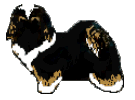 TRI COLOUR - CLASSIC: A classic tricolour is basically a Black and Tan dog with the addition of white in the parti or pied marking pattern. Some registries use the terms Black and Tan with white markings rather than Tricolour. Other three-colour variations may occur, with silver points rather than tan, or other dark base colours rather than black. See photos in Gallery 4
TRI COLOUR - CLASSIC: A classic tricolour is basically a Black and Tan dog with the addition of white in the parti or pied marking pattern. Some registries use the terms Black and Tan with white markings rather than Tricolour. Other three-colour variations may occur, with silver points rather than tan, or other dark base colours rather than black. See photos in Gallery 4
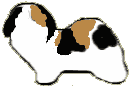 BI-COLOURED PARTI: Three distinct colours in the coat; white plus any other two colours.
Markings may be similar to those seen on a Beagle or Fox hound (hound-marked), but there can be combinations other than Black/Tan/White. The term Bi-Coloured Parti is more accurate, meaning a particoloured dog with two different colour patches plus white. See photos in Gallery 4
BI-COLOURED PARTI: Three distinct colours in the coat; white plus any other two colours.
Markings may be similar to those seen on a Beagle or Fox hound (hound-marked), but there can be combinations other than Black/Tan/White. The term Bi-Coloured Parti is more accurate, meaning a particoloured dog with two different colour patches plus white. See photos in Gallery 4